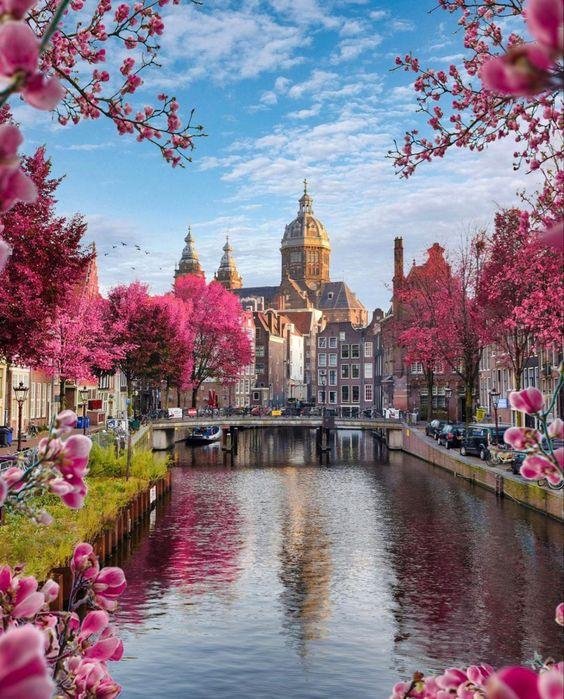Muscat, the capital city of Oman, is a captivating blend of traditional Arabian architecture and modern design, reflecti...
The Architectural Wonders of Amsterdam: A Tapestry of History and Innovation
Amsterdam, the capital of the Netherlands, is renowned for its picturesque canals, vibrant culture, and rich architectural heritage. The city's unique architectural landscape is characterized by narrow, gabled houses, historic buildings, and modern structures that coexist harmoniously. Amsterdam's architecture tells the story of its past, reflecting its rise as a major trading hub during the Dutch Golden Age and its evolution into a contemporary metropolis.

One of the most iconic features of Amsterdam is its canal ring, a UNESCO World Heritage Site. The canals, built in the 17th century, are lined with distinctive narrow houses that showcase the Dutch Renaissance style. These homes, often adorned with ornate gables and large windows, were designed to maximize space and light. The gables not only add aesthetic appeal but also served practical purposes, allowing for the easy hoisting of goods to upper floors.
Among the most famous buildings in Amsterdam is the Anne Frank House, a poignant reminder of the city's history during World War II. The house, where Anne Frank wrote her diary while hiding from the Nazis, is preserved as a museum and attracts millions of visitors each year. Its simple yet powerful architecture stands in stark contrast to the surrounding modern buildings, symbolizing the resilience of the human spirit.

Another architectural gem is the Rijksmuseum, the national museum of the Netherlands, which showcases an impressive collection of art and history. The museum, designed by architect Pierre Cuypers and opened in 1885, features a stunning neo-Gothic façade and a grand entrance that welcomes visitors into its vast galleries. The Rijksmuseum's design reflects the Dutch passion for art and culture, making it a cornerstone of Amsterdam's architectural heritage.
The Royal Palace of Amsterdam, located at Dam Square, is another significant landmark. Originally built as a city hall in the 17th century, the palace exemplifies the classic Dutch Baroque style. Its opulent interiors and grand architecture serve as a testament to the Netherlands' historical wealth and influence. The palace remains an active site for royal events, connecting the past with the present.
As the city evolved, so did its architectural styles. The late 19th and early 20th centuries saw the emergence of the Amsterdam School, an architectural movement characterized by its expressive forms and intricate brickwork. The Het Schip building, designed by architect Michel de Klerk, is a prime example of this style. Its dynamic façade and decorative elements reflect the social ideals of the time, emphasizing community and cohesion.
Modern architecture also plays a vital role in Amsterdam's landscape. The Eye Filmmuseum, completed in 2012, is a striking example of contemporary design. Its futuristic structure, situated on the waterfront, features a bold white exterior and asymmetrical shapes that challenge traditional architectural norms. The museum serves as a cultural hub for film enthusiasts, showcasing both classic and contemporary cinema while providing stunning views of the city.
Another notable modern building is the A'DAM Tower, a former office building transformed into a creative hub. The tower's distinctive design and vibrant atmosphere have made it a focal point for artists, entrepreneurs, and tourists. It features a rooftop observation deck with breathtaking views of Amsterdam, encapsulating the city's spirit of innovation and creativity.
Amsterdam's commitment to sustainability is evident in its architecture as well. The city has embraced green building practices, with numerous projects focusing on eco-friendly design. The Van Dijk en Ko building, for instance, incorporates green roofs and energy-efficient systems, demonstrating the city's dedication to environmental responsibility while maintaining its architectural heritage.
The blend of historic and modern architecture in Amsterdam creates a unique urban environment that enchants residents and visitors alike. The city's layout, with its canals and narrow streets, encourages exploration and discovery. Each neighborhood offers a distinct architectural flavor, from the elegant facades of the Jordaan to the modernist buildings in the Zuidas business district.

In conclusion, Amsterdam's architecture is a captivating journey through time, reflecting the city's rich cultural heritage and innovative spirit. From historic canal houses to contemporary masterpieces, each structure contributes to the vibrant tapestry of Amsterdam's urban landscape.
The city invites exploration, offering a unique experience for architecture enthusiasts and casual visitors alike. As you wander through its streets, you’ll discover that Amsterdam is not just a city of canals and bicycles; it is a living museum of architectural wonders that tells the story of its past while embracing the future.
Amsterdam’s ability to harmoniously blend tradition with innovation makes it a truly remarkable destination, and its architectural gems are a testament to the creativity and resilience of its people. Whether you’re admiring the intricate gables of a 17th-century house or marveling at a cutting-edge modern building, the architectural wonders of Amsterdam offer a glimpse into the city’s soul, inviting you to appreciate its history and envision its future.
Share:




